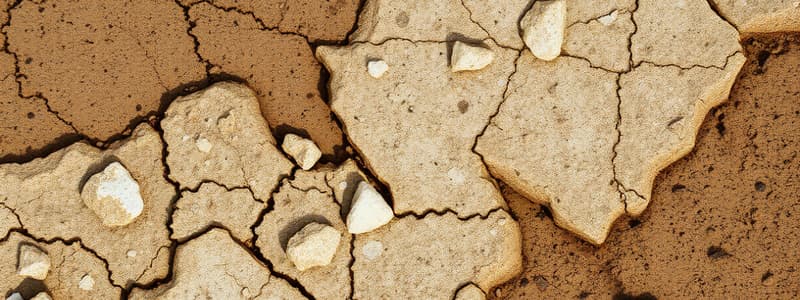Podcast
Questions and Answers
What is the primary effect of hydrolysis on minerals?
What is the primary effect of hydrolysis on minerals?
- It hardens minerals into crystals.
- It completely dissolves minerals into a solution. (correct)
- It enhances mineral color.
- It forms fossils.
Which process is commonly associated with the formation of rust on iron?
Which process is commonly associated with the formation of rust on iron?
- Hydrolysis
- Oxidation (correct)
- Acidification
- Carbonation
What chemical reaction occurs during carbonation in limestone?
What chemical reaction occurs during carbonation in limestone?
- Oxygen reacts with calcium.
- Minerals crystallize into solid phases.
- Rainwater mixes with nutrients.
- Rainwater reacts with carbon dioxide to form carbonic acid. (correct)
How does acidification mainly impact the environment?
How does acidification mainly impact the environment?
Which organisms are primarily responsible for bio-chemical weathering?
Which organisms are primarily responsible for bio-chemical weathering?
What is a significant consequence of acid rain on structures?
What is a significant consequence of acid rain on structures?
Which of the following best describes the role of plant growth in weathering?
Which of the following best describes the role of plant growth in weathering?
What is the primary difference between mechanical weathering and chemical weathering?
What is the primary difference between mechanical weathering and chemical weathering?
Which chemical reaction is NOT associated with chemical weathering?
Which chemical reaction is NOT associated with chemical weathering?
What role does water play in hydrolysis?
What role does water play in hydrolysis?
Which of the following is an example of how hydrolysis can alter minerals?
Which of the following is an example of how hydrolysis can alter minerals?
Which factor is NOT a contributor to the process of chemical weathering?
Which factor is NOT a contributor to the process of chemical weathering?
Why might chemical weathering lead to increased mechanical weathering?
Why might chemical weathering lead to increased mechanical weathering?
What is one everyday application of minerals extracted through chemical weathering?
What is one everyday application of minerals extracted through chemical weathering?
Which type of chemical weathering specifically involves living organisms?
Which type of chemical weathering specifically involves living organisms?
Flashcards
Chemical Weathering
Chemical Weathering
The breakdown of rocks and minerals by chemical reactions, altering their composition.
Hydrolysis
Hydrolysis
Chemical weathering process where water breaks down the chemical bonds in a mineral, creating new compounds.
Oxidation
Oxidation
Chemical reaction involving oxygen, often leading to the formation of oxides and rust.
Acidification
Acidification
Signup and view all the flashcards
Carbonation
Carbonation
Signup and view all the flashcards
Igneous Rocks
Igneous Rocks
Signup and view all the flashcards
Feldspar
Feldspar
Signup and view all the flashcards
Soil Formation
Soil Formation
Signup and view all the flashcards
What dissolves minerals in water?
What dissolves minerals in water?
Signup and view all the flashcards
Why does iron rust?
Why does iron rust?
Signup and view all the flashcards
How does carbonation break down rocks?
How does carbonation break down rocks?
Signup and view all the flashcards
What causes acidification?
What causes acidification?
Signup and view all the flashcards
How do living organisms weather rocks?
How do living organisms weather rocks?
Signup and view all the flashcards
What causes Mars' red color?
What causes Mars' red color?
Signup and view all the flashcards
What happens to limestone during carbonation?
What happens to limestone during carbonation?
Signup and view all the flashcards
Study Notes
Chemical Weathering Overview
- Chemical weathering breaks down rocks and minerals through chemical reactions rather than physical processes.
- These reactions alter the composition of minerals, producing new minerals.
- This process creates the parent material for soil formation.
- Key minerals extracted through weathering (e.g., calcium, phosphorus) are used in various applications (e.g., agriculture).
- Examples include rust (from oxidation), acid rain (from carbonic acid dissolving rock), and dissolution processes.
- Chemical weathering weakens rock structure, making it more susceptible to mechanical weathering.
Types of Chemical Weathering
- Several factors drive chemical weathering including water, oxygen, acids (like carbonic acid), carbon dioxide, and Earth's organisms.
- Five main types: carbonation, hydrolysis, oxidation, acidification, and biological weathering (e.g., from lichens).
Hydrolysis
- Hydrolysis is a chemical weathering process where water breaks down mineral bonds.
- Water reacts with mineral compounds, creating weak acids in the process.
- Hydrolysis often forms new, weaker compounds than the original mineral.
- Common in igneous rocks and alters minerals such as feldspar into clay.
- May dissolve minerals completely.
Oxidation
- Oxidation occurs when oxygen reacts with metal elements (e.g., iron) in rocks.
- It creates oxides (e.g., hematite, magnetite), often producing a reddish-brown color (like rust).
- Weakens rock structure and accelerates the decay process.
- An example is the reddish color of Mars' surface.
Carbonation
- Carbonation happens when rain and carbon dioxide combine to form carbonic acid.
- Carbonic acid dissolves limestone creating a calcium bicarbonate solution.
- This soluble solution erodes or weathers the limestone.
- More acidic conditions (i.e., acid rain) accelerate this process.
- Common in wet climates and linked to sinkholes, caves, and underground rivers in limestone and dolomite.
Acidification
- Acidification mainly affects water bodies (groundwater, streams, lakes, oceans).
- Natural acidification is balanced, however, high acidity disrupts ecological processes.
- Increased acidification from pollution (fossil fuels, chemicals) leads to adverse impacts.
- Reduced oxidation potential and altered pH impacting aquatic ecosystems.
- Impacts soils through acidic rain, causing decays in both natural and artificial materials
Biological Weathering
- Living organisms also weather rocks through bio-chemical processes.
- Lichens and algae release organic compounds and act like weak acids to disintegrate rock.
- Plant growth, burrowing animals (e.g., snails) also contribute, creating weaker materials.
- Organisms accelerate the breakdown process releasing substances that cause decay in rocks.
Studying That Suits You
Use AI to generate personalized quizzes and flashcards to suit your learning preferences.



